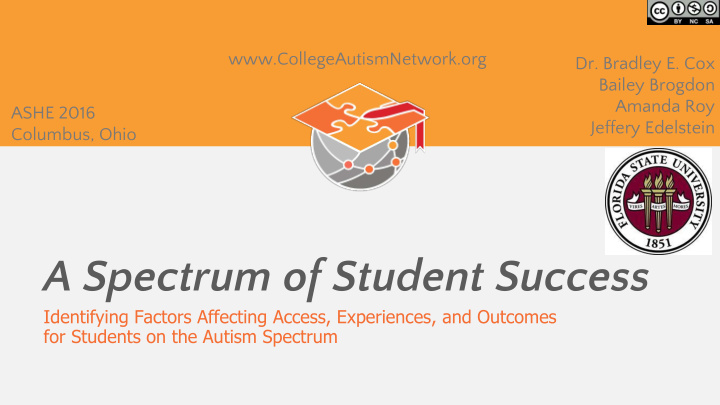



www.CollegeAutismNetwork.org Dr. Bradley E. Cox Bailey Brogdon Amanda Roy ASHE 2016 Jeffery Edelstein Columbus, Ohio A Spectrum of Student Success Identifying Factors Affecting Access, Experiences, and Outcomes for Students on the Autism Spectrum CollegeAutismNetwork.org
Sneak Peak Personal Connections Individual Emerging • Family/Friends • Past experiences • Resource advisors convergence Personalized Model of Adaptation Convergence Identity • Knowledge • Acceptance • Salience Formal Accommodations ASD Institutional Standard Operating Environment Procedures
Autism Coming to College Recent Estimates: 16,000 1 or 143,500 2 or 389,500 2 … but by 2020: up to 433,000 3 1 From Wei, Wagner, Hudson, Enrollment Growth Relative to 2010 3 Yu, & Javitz (2015) [n=920; 13-16 year-olds from 2000 using national NLTS-2 dataset] 2 Author extrapolations from White, Ollendick, and Bray (2011) [n=667; enrolled college students at single 4-year institution] 3 Author extrapolations from CDC data CollegeAutismNetwork.org
Challenges at Two Levels Individuals Institutions Social Identification Academic Coordination Independent Living Individualization Resources/Efficiency “Co-Morbidities” Fewer than 39% graduate CollegeAutismNetwork.org
Methods Overview Framework Analyses in 3 Phases ○ Astin’s I-E-O ● Phase 1 ○ Constant Comparative Approach ○ Multiple Case Study ● Phase 2 ○ Grounded Theory ○ Transcript Coding (IEO a priori ) ○ Multiple-Raters & Memos Data ○ Semi-Structured Interviews ● Phase 3 ○ 9 Students with Autism ○ 9-Step Proposition Refinement ○ Wide-ranging ages, severity, ○ Model-Building experiences, and outcomes CollegeAutismNetwork.org
Emerging Model of Personal Connections Individual Convergence • Family/Friends • Past experiences • Resource advisors convergence Personalized Adaptation Identity • Knowledge • Acceptance • Salience Formal Accommodations ASD Institutional Standard Operating Environment Procedures
Step 1: Autism Spectrum Disorders & Standard Operating Procedures ASD ● Difficulties with social communication & peer interaction ● Literal and rigid expectations Standard Operating Procedures ● e.g., orientation, large lectures Problem Realization ● ASD-heightened & ASD-specific ○ Guidance/Support from advisors & instructors ○ Academic performance, group work CollegeAutismNetwork.org
Evidence Step 1: Autism Spectrum Disorders & Standard Operating Procedures “I’m a linear learner. I mean, I’m autistic. And if it’s not linear I can’t learn it.” - Brian “She doesn’t have time for me. That’s the problem. I need someone to work with me more. She doesn’t have time, she doesn't have time to help me. Not with all these other students.” - Brian CollegeAutismNetwork.org
Step 2: Identity & Formal Accommodations Identity ● Variation in the knowledge, acceptance, and salience of autism shaped how the students responded to their problem(s) Formal Accommodations ● Specific disability accommodations provided by an institution ○ e.g., extended time on test, note-taker ● Students experienced several barriers to access accommodations Problem (Re)Defining ● Surface-level problems can arise from students’ autistic characteristics, but… ● Problems often had a deeper root tied to their identity, so... ● Problem must be redefined to capture the deeper/bigger issue(s) CollegeAutismNetwork.org
Evidence Step 2: Identity and Formal Accommodations “We really had a heart-to-heart discussion with the disability resource center and some of the professors regarding the levels of calculus I’d have to take. I even got to look at some of their textbooks. I kind of had a bit of a panic attack... We talked it over and I just told my parents ‘I honestly don’t think I can do this. As much as I would love to be able to go here and study this realistically I don’t - I’m going to get lost.’ ... Given that I would be miles away from my parents, living on my own and taking these really difficult classes, I know that I have limits. I was very certain that that was it.” - Christopher CollegeAutismNetwork.org
Step 3: Personal Connections & Personalized Adaptation Personal Connections ● Typically a family member, guidance counselor, or mentor Personalized Adaptation ● Institutional resources, norms, accommodations, or policies seen as malleable and adaptable to the needs of the individual student (Re)Solving the Problem ● Self-help, enrolling in another institution CollegeAutismNetwork.org
Getting Ahead of Predictable Problems: Orientation Predictable Problem ○ Overwhelming high-energy activities ○ Difficult to switch attention between topics and integrate various sources of information rapidly ○ Difficulties maintaining eye contact and small talk among peers Potential Solutions ○ Printed or digital presentations available before and after ○ Hourly “self-care” or “personal rejuvenation” breaks CollegeAutismNetwork.org
Getting Ahead of Predictable Problems: Conduct Predictable Problem ○ Difficulty recognizing, defining, and following ambiguous “social rules” or “informal policy” ○ “Social rules” of college are not explicitly laid out ■ e.g., living with a roommate, eating in a cafeteria, going to a party Potential Solution ○ Students with autism tend to recognize and implement rule-based frames ○ Adhere to clearly articulated policies ○ Explore peer-mentors to guide navigation through novel social contexts CollegeAutismNetwork.org
Getting Beyond the Disability Service Center Disability Service Center ○ The “default” problem-solving starting place ○ Too often, the real or assumed ending place Potential Solutions: ● A specific advisor or “case worker” for students to navigate the institution ○ Point of contact for neurodiverse students ○ Liaison between the departments and the neurodiverse students ■ e.g., help navigate a roommate agreement, find a proper tutor ● Train their employees to better serve neurodiverse students ● Present important procedures and information in a linear fashion CollegeAutismNetwork.org
Moving Forward Autism-Related Characteristics in College STEM Students: Prevalence, Performance, and Mediation (1) determine the prevalence of autism-related characteristics among college students entering STEM fields; (2) assess the effect of autism-related characteristics on student performance in gateway STEM courses; and (3) evaluate the effect of formal disability accommodations on the classroom performance of STEM students with autism-related characteristics. CollegeAutismNetwork.org
College Autism Network Advocacy Research Training We would like to thank the participants in this study, all contributors to the paper, and the College Autism Network! Full Paper Available at www.CollegeAutismNetwork.org Dr. Bradley E. Cox CollegeAutismNetwork.org brad.cox@fsu.edu
Recommend
More recommend